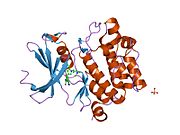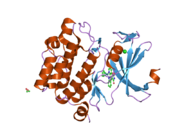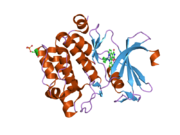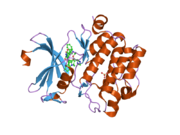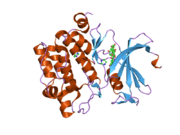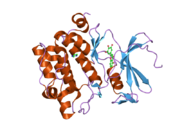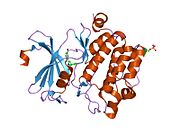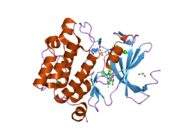Biology:PIM1
 Generic protein structure example |
Proto-oncogene serine/threonine-protein kinase Pim-1 is an enzyme that in humans is encoded by the PIM1 gene.[1][2][3]
Pim-1 is a proto-oncogene which encodes for the serine/threonine kinase of the same name. The pim-1 oncogene was first described in relation to murine T-cell lymphomas, as it was the locus most frequently activated by the Moloney murine leukemia virus.[4] Subsequently, the oncogene has been implicated in multiple human cancers, including prostate cancer, acute myeloid leukemia and other hematopoietic malignancies.[5] Primarily expressed in spleen, thymus, bone marrow, prostate, oral epithelial, hippocampus and fetal liver cells, Pim-1 has also been found to be highly expressed in cell cultures isolated from human tumors.[4] Pim-1 is mainly involved in cell cycle progression, apoptosis and transcriptional activation, as well as more general signal transduction pathways.[4] Pim-1's role in oncogenic signalling has led to it becoming a widely studied target in cancer research, with numerous drug candidates under investigation which target it.[6][7]
Gene
Located on chromosome 6 (6p21.2), the gene encompasses 5Kb of DNA, including 6 exons and 5 introns. Expression of Pim-1 has been shown to be regulated by the JAK/STAT pathway. Direct binding of transcription factors STAT3 and STAT5 to the Pim-1 promoter results in the transcription of Pim-1.[4] The Pim-1 gene has been found to be conserved in dogs, cows, mice, rats, zebrafish and C. elegans. Pim-1 deficient mice have been shown to be phenotypically normal, indicating that there is redundancy in the function of this kinase.[4] In fact, sequence homology searches have shown that two other Pim-1-like kinases, Pim-2 and Pim-3, are structurally and functionally similar.[4] The Pim-1 gene encodes has multiple translation initiation sites, resulting in two proteins of 34 and 44kD.[4]
Protein structure
Human, murine and rat Pim-1 contain 313 amino acids, and have a 94 – 97% amino acid identity.[4] The active site of the protein, ranging from amino acids 38-290, is composed of several conserved motifs, including a glycine loop motif, a phosphate binding site and a proton acceptor site.[4] Modification of the protein at amino acid 67 (lysine to methionine) results in the inactivation of the kinase.[4]
Activation and stabilization
Pim-1 is primarily involved in cytokine signaling, and has been implicated in many signal transduction pathways. Because Pim-1 transcription is initiated by STAT3 and STAT5, its production is regulated by the cytokines that regulate the STAT pathway, or STAT factors. These include interleukins (IL-2, IL-3,IL-5, IL-6, IL-7, IL12, IL-15), prolactin, TNFα, EGF and IFNγ, among others.[4] Pim-1 itself can bind to negative regulators of the JAK/STAT pathway, resulting in a negative feedback loop.
Although little is known about the post-transcriptional modifications of Pim-1, it has been hypothesized that Hsp90 is responsible for the folding and stabilization of Pim-1, although the exact mechanism has yet to be discovered.[4] Furthermore, the serine/threonine phosphatase PP2 has been shown to degrade Pim-1.
Interactions
PIM1 has been shown to interact with:
- CBX3,[8]
- CDC25A,[9]
- Heat shock protein 90kDa alpha (cytosolic), member A1,[10]
- NFATC1,[11]
- Nuclear mitotic apparatus protein 1,[12]
- P21,[13]
- SND1[14] and
- RELA.[15]
Other known substrates/binding partners of Pim-1 include proteins involved in transcription regulation (nuclear adaptor protein p100, HP-1, PAP-1 and TRAF2 / SNX6), and regulation of the JAK/STAT pathway (SOCS1 and SOCS3).[4] Furthermore, Pim-1 has been shown to be a cofactor for c-Myc, a transcription factor believed to regulate 15% of all genes, and their synergy has been in prostate tumorigenesis.[16]
Pim-1 is able to phosphorylate many targets, including itself. Many of its targets are involved in cell cycle regulation.
Activates
- Cdc25C (G1/S positive regulator): Activation results in increased G1 → S[4]
- Cdc25C (G2/M positive regulator): Activation results in increased G2 → M[4]
Deactivates
- Bad (Pro-apoptotic protein): Deactivation results in increased cell survival[4]
- CKI (G1/S negative regulator): Deactivation results in increased G1 → S[4]
- C-TAK1 (Cdc25C inhibitor): Deactivation results in increased G2 → M[4]
Clinical implications
Pim-1 is directly involved in the regulation of cell cycle progression and apoptosis, and has been implicated in numerous cancers including prostate cancer, Burkitt's lymphoma and oral cancer, as well as numerous hematopoietic lymphomas. Single nucleotide polymorphisms in the Pim-1 gene have been associated with increased risk for lung cancer in Korean patients, and have also been found in diffuse large cell lymphomas.[17] As well as showing useful activity against a range of cancers,[7] PIM kinase inhibitors have also been suggested as possible treatments for Alzheimer's disease.[18] PIM expression is sufficient to drive resistance to anti-angiogenic agents in prostate and colon cancer models, although the mechanism is not fully elucidated.[19] It has been suggested that a co-targeted therapeutic approach to inhibition of Pim-1 in cancer may be preferable, with suggested co-targets including the PI3K pathway and more.[6] PIM1 expression was found to be elevated during aging and to contribute to the development of pulmonary fibrosis.[20]
Inhibitors
A large number of small molecule inhibitors of PIM1 have been developed. Clinical trial results so far have showed promising anti-cancer activity, but side effects due to insufficient selectivity have proved problematic and research continues to find more potent and selective inhibitors for this target.[21][22][23][24][25][26][27][6][7]
- Examples
References
- ↑ "Entrez Gene: PIM1 pim-1 oncogene". https://www.ncbi.nlm.nih.gov/sites/entrez?Db=gene&Cmd=ShowDetailView&TermToSearch=5292.
- ↑ "Comparison of the human and mouse PIM-1 cDNAs: nucleotide sequence and immunological identification of the in vitro synthesized PIM-1 protein". Oncogene Research 1 (1): 103–12. June 1987. PMID 3329709.
- ↑ "Characterization of the human PIM-1 gene: a putative proto-oncogene coding for a tissue specific member of the protein kinase family". Oncogene Research 1 (1): 87–101. June 1987. PMID 3329711.
- ↑ 4.00 4.01 4.02 4.03 4.04 4.05 4.06 4.07 4.08 4.09 4.10 4.11 4.12 4.13 4.14 4.15 4.16 4.17 "The serine/threonine kinase Pim-1". The International Journal of Biochemistry & Cell Biology 37 (4): 726–30. April 2005. doi:10.1016/j.biocel.2004.11.005. PMID 15694833.
- ↑ "Pim-1 Oncogene". http://atlasgeneticsoncology.org/Genes/GC_PIM1.html.
- ↑ 6.0 6.1 6.2 "PIM kinase inhibition: co-targeted therapeutic approaches in prostate cancer". Signal Transduction and Targeted Therapy 5: 7. 2020. doi:10.1038/s41392-020-0109-y. PMID 32025342.
- ↑ 7.0 7.1 7.2 "Current perspectives on targeting PIM kinases to overcome mechanisms of drug resistance and immune evasion in cancer". Pharmacology & Therapeutics 207: 107454. March 2020. doi:10.1016/j.pharmthera.2019.107454. PMID 31836451. https://discovery.ucl.ac.uk/id/eprint/10088376/1/1-s2.0-S0163725819302062-main.pdf.
- ↑ "Identification of heterochromatin protein 1 (HP1) as a phosphorylation target by Pim-1 kinase and the effect of phosphorylation on the transcriptional repression function of HP1(1)". FEBS Letters 467 (1): 17–21. February 2000. doi:10.1016/S0014-5793(00)01105-4. PMID 10664448.
- ↑ "Physical and functional interactions between Pim-1 kinase and Cdc25A phosphatase. Implications for the Pim-1-mediated activation of the c-Myc signaling pathway". The Journal of Biological Chemistry 274 (26): 18659–66. June 1999. doi:10.1074/jbc.274.26.18659. PMID 10373478.
- ↑ "Regulation of Pim-1 by Hsp90". Biochemical and Biophysical Research Communications 281 (3): 663–9. March 2001. doi:10.1006/bbrc.2001.4405. PMID 11237709.
- ↑ "Cutting edge: Transcriptional activity of NFATc1 is enhanced by the Pim-1 kinase". Journal of Immunology 168 (4): 1524–7. February 2002. doi:10.4049/jimmunol.168.4.1524. PMID 11823475.
- ↑ "Pim-1 associates with protein complexes necessary for mitosis". Chromosoma 111 (2): 80–95. July 2002. doi:10.1007/s00412-002-0192-6. PMID 12111331.
- ↑ "Phosphorylation of the cell cycle inhibitor p21Cip1/WAF1 by Pim-1 kinase". Biochimica et Biophysica Acta (BBA) - Molecular Cell Research 1593 (1): 45–55. December 2002. doi:10.1016/S0167-4889(02)00347-6. PMID 12431783.
- ↑ "Pim-1 kinase and p100 cooperate to enhance c-Myb activity". Molecular Cell 2 (4): 417–25. October 1998. doi:10.1016/S1097-2765(00)80141-0. PMID 9809063.
- ↑ "Pim-1 controls NF-kappaB signalling by stabilizing RelA/p65". Cell Death and Differentiation 17 (4): 689–98. April 2010. doi:10.1038/cdd.2009.174. PMID 19911008.
- ↑ "Pim1 kinase synergizes with c-MYC to induce advanced prostate carcinoma". Oncogene 29 (17): 2477–87. April 2010. doi:10.1038/onc.2010.10. PMID 20140016.
- ↑ "Association of single nucleotide polymorphisms in PIM-1 gene with the risk of Korean lung cancer". Cancer Research and Treatment 40 (4): 190–6. December 2008. doi:10.4143/crt.2008.40.4.190. PMID 19688129.
- ↑ "Pim1 inhibition as a novel therapeutic strategy for Alzheimer's disease". Molecular Neurodegeneration 11 (1): 52. July 2016. doi:10.1186/s13024-016-0118-z. PMID 27412291.
- ↑ "Hypoxia-Inducible PIM Kinase Expression Promotes Resistance to Antiangiogenic Agents". Clinical Cancer Research 24 (1): 169–180. 2018. doi:10.1158/1078-0432.CCR-17-1318. PMID 29084916.
- ↑ "Transcriptional analysis of lung fibroblasts identifies PIM1 signaling as a driver of aging-associated persistent fibrosis". JCI Insight 7 (6). February 2022. doi:10.1172/jci.insight.153672. PMID 35167499.
- ↑ "Pim kinase inhibitors: a survey of the patent literature". Expert Opinion on Therapeutic Patents 20 (2): 193–212. February 2010. doi:10.1517/13543770903496442. PMID 20100002.
- ↑ "PIM1 kinase as a target for cancer therapy". Expert Opinion on Investigational Drugs 21 (4): 425–36. April 2012. doi:10.1517/13543784.2012.668527. PMID 22385334.
- ↑ "A small-molecule inhibitor of PIM kinases as a potential treatment for urothelial carcinomas". Neoplasia 16 (5): 403–412. May 2014. doi:10.1016/j.neo.2014.05.004. PMID 24953177.
- ↑ "Small molecule inhibitors of PIM1 kinase: July 2009 to February 2013 patent update". Expert Opinion on Therapeutic Patents 24 (1): 5–17. January 2014. doi:10.1517/13543776.2014.848196. PMID 24131033.
- ↑ "Targeting the Pim kinases in multiple myeloma". Blood Cancer Journal 5 (7): e325. July 2015. doi:10.1038/bcj.2015.46. PMID 26186558.
- ↑ "Targeting Pim kinases for cancer treatment: opportunities and challenges". Future Medicinal Chemistry 7 (1): 35–53. 2015. doi:10.4155/fmc.14.145. PMID 25582332.
- ↑ "Pim-1 kinase as cancer drug target: An update". Biomedical Reports 4 (2): 140–146. February 2016. doi:10.3892/br.2015.561. PMID 26893828.
- ↑ "AZD1208, a potent and selective pan-Pim kinase inhibitor, demonstrates efficacy in preclinical models of acute myeloid leukemia". Blood 123 (6): 905–13. February 2014. doi:10.1182/blood-2013-04-495366. PMID 24363397.
- ↑ "Identification of N-(4-((1R,3S,5S)-3-Amino-5-methylcyclohexyl)pyridin-3-yl)-6-(2,6-difluorophenyl)-5-fluoropicolinamide (PIM447), a Potent and Selective Proviral Insertion Site of Moloney Murine Leukemia (PIM) 1, 2, and 3 Kinase Inhibitor in Clinical Trials for Hematological Malignancies". Journal of Medicinal Chemistry 58 (21): 8373–86. November 2015. doi:10.1021/acs.jmedchem.5b01275. PMID 26505898.
- ↑ "Pharmacologic inhibition of Pim kinases alters prostate cancer cell growth and resensitizes chemoresistant cells to taxanes". Molecular Cancer Therapeutics 8 (10): 2882–93. October 2009. doi:10.1158/1535-7163.MCT-09-0293. PMID 19825806.
- ↑ "Mechanisms of cytotoxicity to Pim kinase inhibitor, SGI-1776, in acute myeloid leukemia". Blood 118 (3): 693–702. July 2011. doi:10.1182/blood-2010-12-323022. PMID 21628411.
- ↑ "A small-molecule inhibitor of PIM kinases as a potential treatment for urothelial carcinomas". Neoplasia 16 (5): 403–12. May 2014. doi:10.1016/j.neo.2014.05.004. PMID 24953177.
Further reading
- "A testis-expressed Zn finger gene (ZNF76) in human 6p21.3 centromeric to the MHC is closely linked to the human homolog of the t-complex gene tcp-11". Genomics 14 (3): 673–9. November 1992. doi:10.1016/S0888-7543(05)80167-3. PMID 1427894.
- "The pim-1 oncogene encodes two related protein-serine/threonine kinases by alternative initiation at AUG and CUG". The EMBO Journal 10 (3): 655–64. March 1991. doi:10.1002/j.1460-2075.1991.tb07994.x. PMID 1825810.
- "Primary structure of the putative human oncogene, pim-1". Gene 90 (2): 303–7. June 1990. doi:10.1016/0378-1119(90)90195-W. PMID 2205533.
- "The human protooncogene product p33pim is expressed during fetal hematopoiesis and in diverse leukemias". Proceedings of the National Academy of Sciences of the United States of America 86 (22): 8857–61. November 1989. doi:10.1073/pnas.86.22.8857. PMID 2682662.
- "Identification of the human pim-1 gene product as a 33-kilodalton cytoplasmic protein with tyrosine kinase activity". Molecular and Cellular Biology 8 (4): 1498–503. April 1988. doi:10.1128/mcb.8.4.1498. PMID 2837645.
- "Cloning and characterization of the human PIM-1 gene: a putative oncogene related to the protein kinases". Journal of Cellular Biochemistry 35 (2): 105–12. October 1987. doi:10.1002/jcb.240350204. PMID 3429489.
- "The cDNA sequence and gene analysis of the human pim oncogene". Gene 54 (1): 105–11. 1987. doi:10.1016/0378-1119(87)90352-0. PMID 3475233.
- "Pim-1 kinase and p100 cooperate to enhance c-Myb activity". Molecular Cell 2 (4): 417–25. October 1998. doi:10.1016/S1097-2765(00)80141-0. PMID 9809063.
- "Physical and functional interactions between Pim-1 kinase and Cdc25A phosphatase. Implications for the Pim-1-mediated activation of the c-Myc signaling pathway". The Journal of Biological Chemistry 274 (26): 18659–66. June 1999. doi:10.1074/jbc.274.26.18659. PMID 10373478.
- "Identification of heterochromatin protein 1 (HP1) as a phosphorylation target by Pim-1 kinase and the effect of phosphorylation on the transcriptional repression function of HP1(1)". FEBS Letters 467 (1): 17–21. February 2000. doi:10.1016/S0014-5793(00)01105-4. PMID 10664448.
- "PAP-1, a novel target protein of phosphorylation by pim-1 kinase". European Journal of Biochemistry 267 (16): 5168–78. August 2000. doi:10.1046/j.1432-1327.2000.01585.x. PMID 10931201.
- "Regulation of Pim-1 by Hsp90". Biochemical and Biophysical Research Communications 281 (3): 663–9. March 2001. doi:10.1006/bbrc.2001.4405. PMID 11237709.
- "Sorting nexin 6, a novel SNX, interacts with the transforming growth factor-beta family of receptor serine-threonine kinases". The Journal of Biological Chemistry 276 (22): 19332–9. June 2001. doi:10.1074/jbc.M100606200. PMID 11279102.
- "Pim-1 negatively regulates the activity of PTP-U2S phosphatase and influences terminal differentiation and apoptosis of monoblastoid leukemia cells". Archives of Biochemistry and Biophysics 390 (1): 9–18. June 2001. doi:10.1006/abbi.2001.2370. PMID 11368509.
- "Hypermutation of multiple proto-oncogenes in B-cell diffuse large-cell lymphomas". Nature 412 (6844): 341–6. July 2001. doi:10.1038/35085588. PMID 11460166.
- "Pim-1 translocates sorting nexin 6/TRAF4-associated factor 2 from cytoplasm to nucleus". FEBS Letters 506 (1): 33–8. September 2001. doi:10.1016/S0014-5793(01)02881-2. PMID 11591366.
- "Cutting edge: Transcriptional activity of NFATc1 is enhanced by the Pim-1 kinase". Journal of Immunology 168 (4): 1524–7. February 2002. doi:10.4049/jimmunol.168.4.1524. PMID 11823475.
- "Complementary functions of the antiapoptotic protein A1 and serine/threonine kinase pim-1 in the BCR/ABL-mediated leukemogenesis". Blood 99 (12): 4531–9. June 2002. doi:10.1182/blood.V99.12.4531. PMID 12036885.
- "Pim-1 associates with protein complexes necessary for mitosis". Chromosoma 111 (2): 80–95. July 2002. doi:10.1007/s00412-002-0192-6. PMID 12111331.
 |


